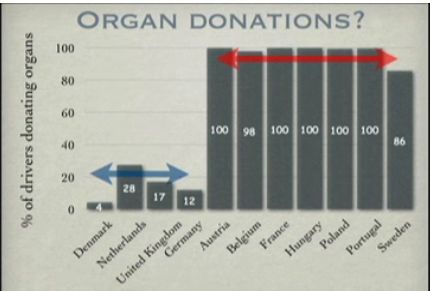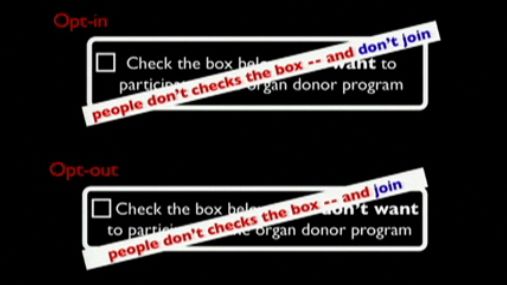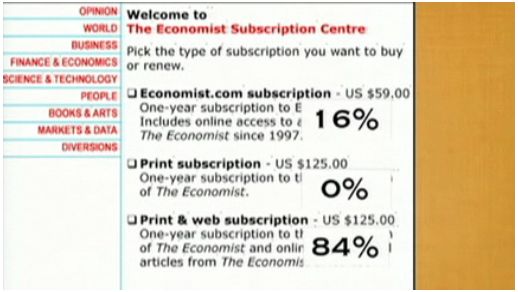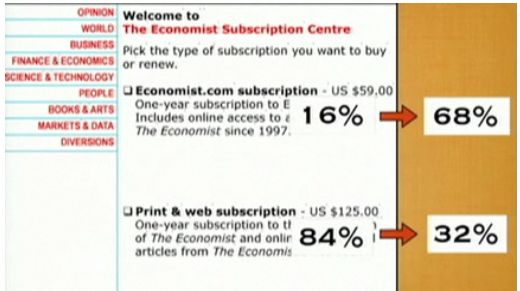
Selling & Upselling with Psychology & Human Behavior
Ted.com is one of my favorite websites ever. The entire site is filled with some of the most interesting, captivating, thought provoking and mind blowing presentations from the world’s top geniuses and experts. I highly recommend clicking around Ted.com and learning something…
I recently watched this particular video called, “Are we in control of our own Decisions?” by Dan Ariely. Dan Ariely is a behavioral economist and wrote the book “Predictably Irrational” (Official Site). His TED Talk is brilliant and has a few ideas that we can use in our online marketing and on our eCommerce websites.
Watch the Video here:
Default Options
One of my favorite takeaways from this video was the idea that a majority of people will simply agree with or comply with the default option. This was evident in the studies that showed the countries with high and low rates of citizens willing to donate their organs. If the question was, “check here to opt in” the country had a low acceptance rate, and when the question was “check here to opt out” the acceptance rate was extremely high.

How can you use this in your marketing?
You can use it in an upsell process. You have to be VERY careful, and transparent when you’re doing it so customers don’t become alienated by your website or flood your customer service number with complaints. Don’t just add extra cost to the checkout, make sure it’s apparent to the customer that it’s happen. There are many marketers and checkout processes that do (usually in the domain registration space (GoDaddy is king), web hosting and info marketing).
Think about this. A product is in your inventory and listed on your site for $10. After the customer gets the product in their cart, and gets to the checkout there is an automatic upsell before the order confirmation. This upsell charges $X that might change the shipping or improve the actual the item in some way by adding a feature, it could be a warranty, insurance, or even an extra product (for example, if you sell glasses, upsell a cleaning and repair kit). If the upsell’s price is marginal (based on the price of the original item, probably adding around 10% – 20% to the order), and the upsell is included by default, you might expect a low rate of opt out based on the data shown by Ariely in the video.

The upsell should be very obvious though so the customer can easily choose to opt out. Just imagine all of your order values increasing by adding in a few upsell options in your checkout and making them the default choice.
Price Anchoring (forcing a Good Deal)
The other takeaway that I thought was excellent and applicable was the price anchoring technique that The Economist magazine uses to drastically increase the number of subscribers that would take a higher priced item. They offer a web only, print only and a web + print option. The Web Only option is $59, the print only is $125, and the web + print is $125. Look at the results that Dan Ariely got from polling students at MIT, with the print only and without the print only options.
The results when the print only deal was an option:

and the results without the print only option:

This is incredible! When people think they are getting a good deal, they are likely to take the good deal but when there are two distinct and different options, price usually wins. Try positioning your products, shipping options or upsells in a way that your customers are getting something for nothing or getting a great deal… A/B test and see what happens. Brainstorm how you can do it like The Economist Magazine did it.
Think about Amazon.com – they offer free “super saver” shipping on any orders over $25. I know that I’ve added an extra product or two into my cart just to get over the minimum price, usually sending it to over $30. I doubt I’m the only one… have you ever done the same thing? This increases the average order value for Amazon which improves their marketing ROI and average $/Visitor among other important stats.
Thanks for reading! Have any feedback or some other ideas from the video? Leave some comments below!
If you liked this article, check out our latest posts:
+ AR & AI: The eCommerce Arms Race
+ How to Create Viral Marketing for eCommerce
+ How All B2C Companies Should Be Marketing By 2020
+ Email Marketing Tips for Retailers
Recent Comments